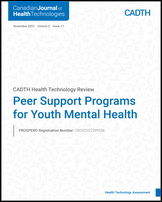|
EveryMind, 2022
| Youth Peer Support Pilot Project | To account for anticipated and unanticipated program outcomes by using an exploratory approach | Process and evaluation questions were developed for program users and workers Process questions were designed to evaluated how the program was implemented and if implementation was as intended Outcome questions were designed to capture changed that occurred because of the program | Program indicators were informed through content-based and demographic questions, program metrics like attendance and number of times program was used, and session topics Formative feedback was collected through survey-based questionnaires on a weekly basis after each session which included quantitative questions and qualitative questions Summative feedback was collected following the program to inform program experiences and program outcomes through qualitative methods Quantitative data were analyzed using metrics such as frequencies, percentages, or mean scores Qualitative data were analyzed using a thematic analysis approach | Formative feedback outcomes included statements about the quality of the content covered, and open-ended questions to assess user and worker experiences Summative feedback outcomes focused on peer support training experiences and youth participant and worker experiences |
|
Foundry Center Office, 2021
| Foundry Youth Peer Support Curriculum | To improve the training experiences of future youth peer support workers To understand the impact on participant preparation for youth peer support practice and to better meet training needs To assess the delivery of virtual training | Participants were invited to complete a survey and participate in focus groups to inform feedback to address quality improvement efforts | Surveys were administered before and after training sessions both in person and online Focus groups were conducted with training participant both in person and virtually Key informant interviews were held with training facilitators Quantitative and qualitative data were analyzed using statistical and thematic coding software | Outcomes were related to the impact of participants through content, delivery, and experience of training Trainer experiences outcomes were also assessed |
|
Centre for Innovation in Peer Support at Support House, 2019
| Just Be You | To provide baseline data on perceived integrity, quality, and impact of peer support services | The evaluation used the PSIQI survey, which was developed in consultation with peer support experts to be used by people who are currently using peer support or have recently stopped using peer support | Participants use the PSIQI survey to inform questions related to connection with peer support, time of engagement, type and focus of peer support offered, service integrity, service quality, and service impact | Outcomes are related to the participants experience of using peer support, and their perceived judgment on service integrity, quality, and impact |
|
University of McGill, 2019
| Peer Support Centre | To determine who accessed peer support services, the mental health needs of students using peer support services, and the perceived quality of peer support reported by students who accessed the service | Participants were invited to complete an anonymous online survey to inform participant experience and program quality improvement | The online survey was made available to participants after their support session to collect information related to mental health status and session quality Mental health status was measured PHQ-9, GAD-7, and the ORS Session quality was measured using the SRS Data processing and analysis was done using descriptive statistics analytical methods (using IBM SPSS version 22) | Mental health status outcomes were related to depressive and anxious symptoms over the past 2 weeks prior to the survey, and personal, interpersonal, social, and general well-being as measured by the PHQ-9, GAD-7, and ORS Session quality outcomes were the perceived quality of the peer support session as reported by the participant measured by the SRS |
